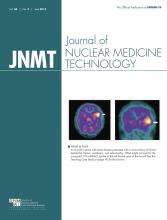Norman E. Bolus, MSPH, MPH, CNMT, FSNMMI-TS
There are many reasons I am passionate about nuclear medicine technology. Perhaps the main reason is the unique ability of nuclear medicine to perform true physiologic imaging. This alone sets it apart from other imaging modalities that can, at best, simulate physiologic imaging through some sort of procedural technique. Add in nuclear medicine therapy, which is becoming more sophisticated, and we have a most unique field that is different from all others. Nuclear medicine provides information that helps physicians diagnose a condition, interpret its characteristics, and treat it more effectively.
Another reason I am passionate about nuclear medicine technology is that the technologist needs to acquire a wide base of knowledge to competently work in the field. Nuclear medicine technology is set apart from the other health professions by requiring an extensive understanding of radiation regulations, radiation safety, radiation biology, radiopharmacy, and specialized instrumentation such as dose calibrators, multichannel analyzers, pocket dosimeters, Geiger counters, and even personal dosimeters. When one considers this daunting background knowledge required of a nuclear medicine technologist, combined with not only the patient-care skills but the high level of communication needed to explain a procedure to a patient or clearly relay information to the patient’s health-care team, it is easy to see how the field of nuclear medicine technology can be something to get passionate about.
I am also amazed by the technologic advances in nuclear medicine over the last 25 years, particularly instrumentation advances such as the addition of CT and MRI to PET to obtain dual-modality information. With every new advance, I become more passionate about what we do. In the future, we are going to become a major part of theranostics as biomarker techniques improve and personalized imaging and therapy become a reality for the mainstream patient. The selling point I use to entice potential students is that our field is ever-changing. New software, new radiopharmaceuticals, and new instrumentation are continually advancing the field and extending our contribution to diagnosis and treatment. There is no stagnation in our field, and at every annual meeting I marvel at the advances I see and hear about, either on the vendor floor or in talks and lectures.
Because of my passion about the field of nuclear medicine technology, I often find myself wanting to become more involved in protecting this field—its uniqueness, its distinction from other modalities—and I never tire of educating the public about what we do and how we do it. Why? Because I feel that the distinctive qualities of our field should be understood and valued, as should our role in that field as professionals who strive to use radioactive materials in a safe and constructive manner. To me it is easy to be passionate about something that I love to explain and do. I am proud to be involved in a continually advancing field that can offer so much to patients, physicians, and scientists.“Follow your passion, be prepared to work hard and sacrifice, and, above all, don’t let anyone limit your dreams.”
—Donovan Bailey
In this edition of JNMT we have 2 original continuing education articles. The first, by Shelley Acuff and Dustin Osborne, is on clinical workflow considerations in the implementation of continuous-bed-motion PET/CT. The second, by Tracey Britton and Nicholas Robinson, describes a few pitfalls and pearls of wisdom in 18F-FDG PET imaging of tumors. I hope you will find both of them informative and helpful in your clinical practice. There are several articles on imaging agents, ranging from relatively new agents such as 177Lu-DOTATATE to 13N-ammonia and 82Rb, as well as an article on improving the accuracy of PET/CT imaging of liver lesions. In addition, there are interesting teaching case studies on a variety of topics: metastatic Merkel cell carcinoma, dermatofibrosarcoma protuberans, meningioma, cardiac sarcoidosis, and infected intracardiac devices. We also have a review by Sara Johnson of the second edition of Nuclear Cardiology Technology Study Guide. I would like to thank all the contributing authors for the time and effort they have put into these articles.
Finally, in a continuing effort to encourage online discussion, I ask that you to go to the SNMMI Facebook page at www.snmmi.org/facebook and join in a conversation we have started on why you are passionate about nuclear medicine technology.








